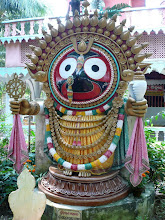 The Daily Tar Heel
The Daily Tar HeelNewspaper
 Four-year-old Lakshmi Manna, of Hillsborough, dances at the Hare Krishna temple in Hillsborough on Sunday night. Hare Krishnas are part of the International Society for Krishna Consciousness, which has about a quarter of a million members across the world.
Four-year-old Lakshmi Manna, of Hillsborough, dances at the Hare Krishna temple in Hillsborough on Sunday night. Hare Krishnas are part of the International Society for Krishna Consciousness, which has about a quarter of a million members across the world.HILLSBOROUGH - Seated on a red-cushioned chair about 6 inches from the floor, Hollie Kennedy swayed from side to side, clapping along with others to the beat of a devotional song.
Indian drums, cymbals and a keyboard-like instrument called a harmonium accompanied the chorus of dozens of devotees. They sat cross-legged on the wooden floor facing Kennedy, who was dressed in all white.
No one paid much attention to the handful of toddlers scurrying around the room.
It was Sunday night at the Hare Krishna temple - the New Goloka Dhama - in Hillsborough.
Minutes after the song, attendees began their well-known chant, the Maha-mantra, an integral part of the Hare Krishna movement.
"Hare Krishna, Hare Krishna, Krishna Krishna, Hare Hare …"
The chant, which can be recited in private with beads or with a group, literally means, "O Krishna, O energy of Krishna, please engage me in Your service."
"By chanting his holy name, you can directly associate with the supreme Lord," said Kennedy, a senior member of the temple and speaker for Sunday's program.
The movement first came to the West in the 1960s through an Indian man named A. C. Bhaktivedanta Swami Prabhupada.
He began the International Society for Krishna Consciousness, which has about a quarter of a million devotees worldwide.
"You have personalities that embody different aspects of God, but they're also fully God," said Jeff Swicegood, the kitchen manager and "munk" of the temple. "Krishna is the original personality of Godhead."
Kennedy said one of the central beliefs is that humans are "all eternal spiritual souls."
"We also believe in reincarnation of the soul according to one's actions," she said. "You can put an end to the cycle by re-establishing a relationship with God."
The men and women wore a line of yellow paint on their foreheads and sat on different sides of the temple.
"It may seem kind of odd and conservative, but the separation between the sexes is meant to make them more peaceful for spiritual advancement," Swicegood said.
The paint, derived from Indian clay, symbolizes the body as a temple of God, he said.
The Hare Krishnas believe in strict adherence to four regulatory principles: no meat, fish or eggs, no intoxication, no gambling and no illicit sex.
Swicegood said these four acts "clear the way" to one's highest intelligence.
"It's like training," he said. Similar to athletes, they "abstain from things to make their workouts more profound."
UNC graduate student and temple member Ellen Crary said the principles help believers serve God.
"You want to become 100-percent conscious of serving God," she said. "At all times, you're acting in a way that is in total congruence with your spiritual nature."
This is part of what attracted Crary to convert in 1982.
"I grew up with a religion that is something that you do on Sunday," she said of her Catholic upbringing. "It's not something that necessarily had a huge impact every other day of the week."
Crary lives across the street from the temple and attends services daily at 4:30 a.m.
Swicegood said that to initiate into the religion, a person must chant 16 rounds each day for one year and follow the four basic principles.
Every Thursday afternoon, he loads up a truck and visits UNC with what he calls "spiritual food" - rice and beans, French bread and juice - to serve up to 100 people.
He said that his belief in Hare Krishna constantly affects him.
"Basically, as soon as I get up in the morning, I start remembering Krishna in so many different ways - chanting Krishna's name, serving Krishna," said Swicegood, who lives in a shed behind the temple.
"Krishna says that when one is in love with him, one glorifies him 24 hours a day."


